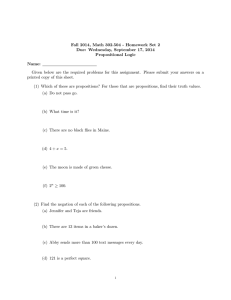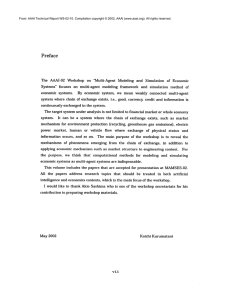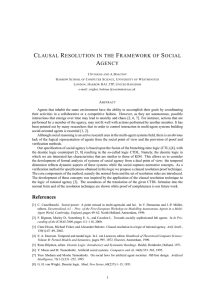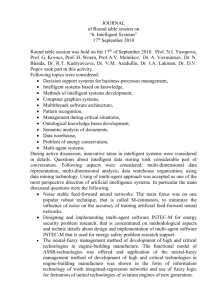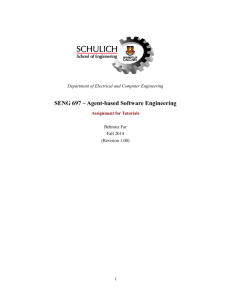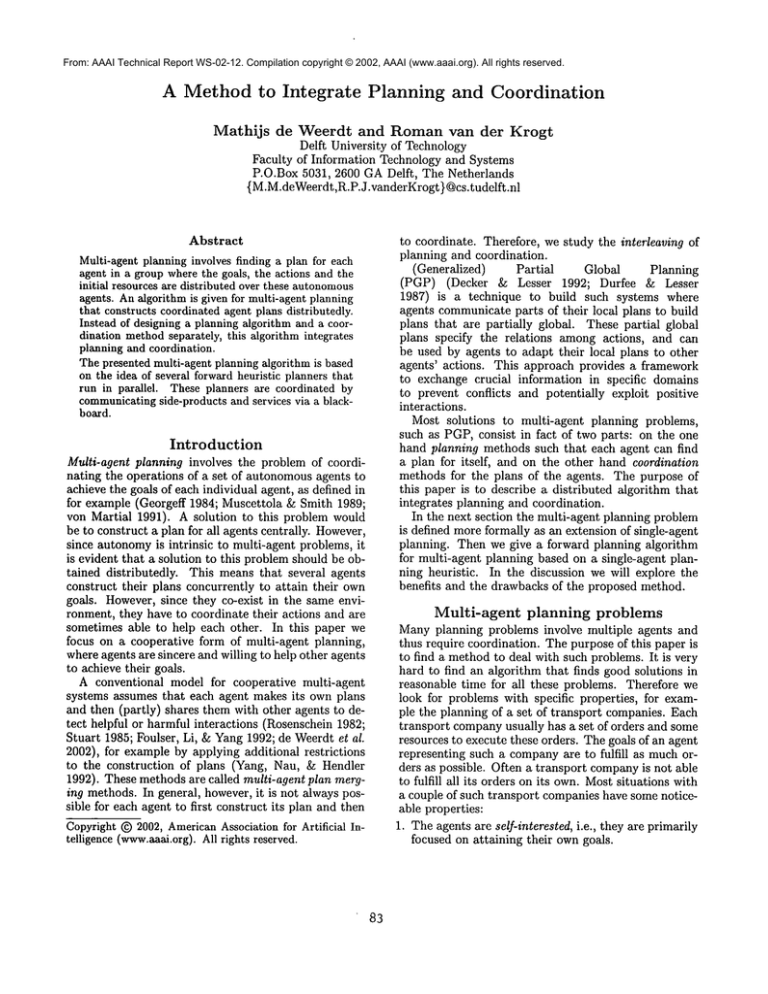
From: AAAI Technical Report WS-02-12. Compilation copyright © 2002, AAAI (www.aaai.org). All rights reserved.
A Method to Integrate
Mathijs
Planning
and Coordination
de
Weerdt
and Roman van der Krogt
Delft University of Technology
Faculty of Information Technology and Systems
P.O.Box 5031, 2600 GADelft, The Netherlands
{M.M.deWeerdt,R.P.J.vanderKrogt } @cs.tudelft.nl
Abstract
Multi-agent planning involves finding a plan for each
agent in a groupwherethe goals, the actions and the
initial resourcesare distributed over these autonomous
agents. Analgorithm is given for multi-agent planning
that constructs coordinated agent plans distributedly.
Instead of designing a planning algorithm and a coordination methodseparately, this algorithm integrates
planning and coordination.
The presentedmulti-agent planning algorithm is based
on the idea of several forward heuristic planners that
run in parallel. These planners are coordinated by
communicating
side-productsand services via a blackboard.
Introduction
Multi-agent planning involves the problem of coordinating the operations of a set of autonomousagents to
achieve the goals of each individual agent, as defined in
for example (Georgeff 1984; Muscettola & Smith 1989;
von Martial 1991). A solution to this problem would
be to construct a plan for all agents centrally. However,
since autonomyis intrinsic to multi-agent problems, it
is evident that a solution to this problem should be obtained distributedly.
This means that several agents
construct their plans concurrently to attain their own
goals. However, since they co-exist in the same environment, they have to coordinate their actions and are
sometimes able to help each other. In this paper we
focus on a cooperative form of multi-agent planning,
where agents are sincere and willing to help other agents
to achieve their goals.
A conventional model for cooperative multi-agent
systems assumes that each agent makes its own plans
and then (partly) shares them with other agents to detect helpful or harmful interactions (Rosenschein 1982;
Stuart 1985; Foulser, Li, & Yang 1992; de Weerdt ctal.
2002), for example by applying additional restrictions
to the construction of plans (Yang, Nan, & Hendler
1992). These methods are called multi-agent plan merging methods. In general, however, it is not always possible for each agent to first construct its plan and then
Copyright(~) 2002, AmericanAssociation for Artificial Intelligence (www.aaai.org).All rights reserved.
83
to coordinate. Therefore, we study the interleaving of
planning and coordination.
(Generalized)
Partial
Global
Planning
(PGP) (Decker & Lesser 1992; Durfee & Lesser
1987) is a technique to build such systems where
agents communicateparts of their local plans to build
plans that are partially global. These partial global
plans specify the relations among actions, and can
be used by agents to adapt their local plans to other
agents’ actions. This approach provides a framework
to exchange crucial information in specific domains
to prevent conflicts and potentially exploit positive
interactions.
Most solutions to multi-agent planning problems,
such as PGP, consist in fact of two parts: on the one
hand planning methods such that each agent can find
a plan for itself, and on the other hand coordination
methods for the plans of the agents. The purpose of
this paper is to describe a distributed algorithm that
integrates planning and coordination.
In the next section the multi-agent planning problem
is defined more formally as an extension of single-agent
planning. Then we give a forward planning algorithm
for multi-agent planning based on a single-agent planning heuristic. In the discussion we will explore the
benefits and the drawbacks of the proposed method.
Multi-agent
planning
problems
Many planning problems involve multiple agents and
thus require coordination. The purpose of this paper is
to find a method to deal with such problems. It is very
hard to find an algorithm that finds good solutions in
reasonable time for all these problems. Therefore we
look for problems with specific properties, for example the planning of a set of transport companies. Each
transport companyusually has a set of orders and some
resources to execute these orders. The goals of an agent
representing such a companyare to i%lfil! as muchorders as possible. Often a transport companyis not able
to fulfill all its orders on its own. Most situations with
a couple of such transport companies have some noticeable properties:
1. The agents are sell-interested, i.e., they are primarily
focused on attaining their owngoals.
2. The (initial) states of the agents are consistent, i.e.,
all agents base their state specification on the current
state of the world, and they are only concerned with
their ownresources and goals.
3. The goals of the agents are consistent, because they
have (usually) different orders (conflict-free).
4. The agents are benevolent, i.e., they are prepared to
help each other (sometimes), because by cooperating
they are able to fulfill moreof their owngoals as well.
5. The agents don’t change the same things in the environment at the same time.
Although for each application some exceptions to these
properties exist, manyapplications, such as cooperating taxi companies, freight transportation companies,
and even military forces, usually have these properties. A problem that has all of the above properties is
called a [distributed self-interested] conflict-free benevolent multi-agent planning problem.
The fact that multiple agents act in the same environment at the same time introduces many complications.
The research topic non-deterministic multi-agent planning deals with situations where the result of an action
is not knownin advance. However,this approach is very
hard, exactly because of the uncertain effects of actions.
Another solution would be to introduce a semaphore to
guarantee that only one agent accesses a certain part
of the world at a time. Such a semaphore can be seen
as another agent controlling only this part of the world.
This latter method matches property 5 above.
Before formally defining the multi-agent planning
problem in detail, we first briefly recapitulate single
agent planning. Much of the following formal notation of a propositional STRIPS(Fikes & Nilsson 1971)
planning instance is based on work done by Nebel. In
propositional STRIPSa state is described by a set of
propositions. Such a state can be transformed into another state by operators. An operator is defined by a
precondition and its effects: o = (pre, eft). The formulas in the precondition of an operator must all be true
in a state to which the operator is applied.
Definition 1 (Nebel 2000) The application of an operator o to a state T is defined as
TtA eff+(o) - ~eff-(o)
if T ~ pre(o) and o is consistent
undefined otherwise
[]
That is, the positive terms in the effect clause (defined
by eff+(o)) will be added to the state and the negations
of the negative effects (defined by -~eff-(o)) will be
removed. Using this definition, the result Res(T, A) of
applying a sequence of operators A to a state T can be
defined.
Definition 2 (Nebel 2000) The result Res(T,A) of
applying a sequence of operators A to a state T is defined by
Res (T, O) :
App(T, o)
84
Res (T, (o; A))
i
res (App(T, o), A)
if App(T, o) is defined
undefined otherwise
[]
Finally, Nebel defines a planning problem in propositional STRIPSas follows:
Definition 3 (Nebel 2000) pl anning pr oblem in
propositional STRIPSis a four-tuple II = (~, O, I, G)
where
¯ E is the set of propositional atoms, called facts,
¯ 0 is the set of operators to describe state-changes,
containing only atoms from ~,
¯ I C E is the initial state, and
¯ G C_ ~ is the goal specification, a set of propositions
that is to be satisfied .
[]
A sequence of operators A = (ol,...,
on) is called a solution or a plan for a planning instance H = (~, O, I, G)
if and only if Res(I, A) ~
Besides planning, in a multi-agent setting, agents also
need to coordinate. Possible conflicts are prevented, because each agent deals with propositions concerning its
’own’ part of the world. However, sometimes an agent
may need to act on something that is administered by
another agent. In such a case the relevant propositions
can be transfered to the agent that needs them. For
example, in a blocks world with multiple agents, each
having one gripper, propositions holding(A) (denoting
that the agent has a block A in its gripper) cannot be
transfered, whereas free(A) (denoting that no block is
on top of A) can. Sometimes, only a special set of
propositions can be exchanged, for example when they
all denote attributes of the same physical object that
agents can interchange. Wewill call such a set of propositions (possibly a singleton) that can be exchanged
resource. So a resource is in fact an object-oriented way
to encapsulate a group of propositions that somehow
belong together.
To represent the transfer of resources from an agent
ai to aj, we introduce two actions:
¯ A get action: get(ai,rk) = (O, rk) to represent receiving resource rk from agent ai. This action requires a put action in the plan of agent ai, but has no
(other) precondition and produces the propositions
rk.
¯ A put action: put(aj,rk) = (rk,’-rk)to
represent
giving resource rk to agent ai. This action has the
propositions of rk as a precondition and consumesall
these propositions.
Note that it should not be possible to include a putaction without the corresponding get-action (or vice
versa). Therefore, we will require that in the final
plan for a multi-agent planning problem, these actions
only come in pairs. This way, propositions that are exchanged are deleted from one agent’s state, and added
to another’s state. This ensures that the same proposition cannot be used by two different agents at the same
time (as required by property 5).
Because most of the current planning domains are
without an explicit time (other than a time step, which
just counts the number of (parallel) actions that have
been performed), it is very well possible for agents to get
into a situation where there is a chain of agents where
each agent is dependent on its successor, and where the
last one is dependent on the first one via get and put
actions. This situation is called a circular dependency
and should not occur in any solution to a multi-agent
planning problem, since such a set of plans cannot be
executed.
Definition 4 For a group of agents A = {ax,...,an}
a multi-agent planning problem is a tuple IIA :
(~,R, {Ha I a ¯ A}) where
¯ ~ is the set of propositional atoms,
* R C 2r~ is the set of (disjunct) resources, and
¯ Ha = (Oa, Ia, Ga), with
- Oa the set of operators to describe state-changes
that can be done by agent a, containing only propositions from ~, including a get and a put action
for each resource/agent combination,
- Ia C_ ~ that part of the initial state that can be
changed by agent a, and
- Ga C_ ~ the goal specification for agent a.
Furthermore, we require that for two agents ai, aj ¯ A:
(i) Ia, n Iaj = O, i.e., each agent knows only about
his own part of the world, and (ii) Ga, n Ga~ = O,
two agents have the same goal (as this could lead to
conflict).
[q
A sequence of operators Aa = (ox,..., on) with oi ¯ Oa,
1 < i < n, is called a solution or a plan for a planning
instance (~,,, R, IIa) = (~,, R, (Oa, Ia, Ga))if and only if
ResW,Aa) ~ Ga.
A solution to a problem HAconsists of a set of consistent solutions AAto all problems in the problem set.
A set of solutions AA= {Aa I a ¯ A} to a planning
instance HAis consistent if and only if:
¯ every Aa ¯ AAis a solution to (~.,R, IIa),
¯ for every get (aj,rk) E Aa, action with i ¢ j, there
is a put (ai, rk) ¯ Aaj, and
¯ the exchange of resources does not introduce circular
dependencies.
Wedefine out(P) as the set of propositions that is the
final state reached by a plan. Such a plan P may be a
partial plan, i.e., a plan that is not yet the solution to
the particular planning problem at hand. Wealso define
in(P) to be the "precondition" of a plan: the smallest
set of propositions that can form an initial state from
which a plan can execute properly.
Finally, in somecases it is convenient for the agents
to have a library of plan schemes PS, filled with plans
for the services they can provide. These plan schemes
are defined as formal plans (i.e., a sequence of actions),
but have no associated initial state or goals. These can
then be used to "advertise" services to other agents.
85
Complexity analysis The following result
derived for a multi-agent planning problem:
can be
Proposition 1 The complexity class of the selfinterested conflict-free benevolent multi-agent planning
problem for n agents with at most m operations each
is equal to that of single-agent planning with O(n ¯ m)
operations.
[]
Proof First, note that multi-agent planning is at least
as hard as single agent planning, since any single agent
planning problem can be translated to a multi-agent
planning problem with exactly one agent. To prove
that it is not harder than single-agent planning, we
show that it is possible to transform the multi-agent
problem to a single-agent problem and that the solution of the single-agent problem can be translated
back, all in polynomial time. Wetranslate the problem
HA= (~, R, {(Oa,Ia,Ga) I a ¯ A}) to a single-agent
problem H = (~’, O, I, G), where
¯ ~’ = UaeA{PaIP¯ ~}, all propositions in ~ are labeled with the names of the agents,
¯ 0 = UaEA {(prea,
ega) (p re, eg ) ¯ Oa} U
{putget= (rk,~,rk,b)lb¯ (A-- {a}),rke R},
possible actions are the actions of the individual
agents, of which the pre- and post-conditions are
labeled with the name of the agent, and actions
putget are added that can change the label of the
propositions in resources from one agent name to
the other,
¯ I = UacA{PaIP¯ Ia}, the initial state is the combination of the initial states of the agents, labeled with
the nameof that agent whose initial state it is, and
¯ G = Ua~a{PalP ¯ Oa}, the goals of the new problem are the goals of the multi-agent problem, again
labeled with the nameof the agent that has that goal.
The solution (which is a sequence of operators A) to this
problem can easily be translated back to a set of multiagent plans Aa: first replace each putget(rk,a, rk,b) action by a put(b, rk,a) and a get(a, rk,b) action.
distribute the actions over the agents: agent ai gets
to execute all actions for which the pre- and postconditions are labeled with ai. Nowremove all labels and
each agent has a plan Aa which can successfully execute
from its initial state Ia to reach its goals Ga.
[]
Forwardheuristic cooperative planning
This section describes an algorithm that facilitates selfinterested cooperative conflict-free planning in a multiagent system, based on a forward heuristic planner for
each agent. This heuristic is similar to the one used
in Fast Forward (FF, see (Hoffmann & Nebel 2001)).
We assume that agents are able to communicate for
cooperation, but each agent is free to decide to what
extent. Communicationis implemented by offering superfluous resources (side-products) to each other, and
by offering resources that one agent is prepared to produce exclusively for another (called services). If the
although in the algorithm below we describe how an
agent offers all its superfluous resources (side-products).
These offers are updated (by UPDATEBB)
each time actions have been added (using the enforced hill-climbing
method given in (Hoffmann & Nebel 2001), called
PLANSTEP
here). Weallow agents to offer two kinds
of resources: firstly, resources in the current state that
they don’t expect to need themselves, that is, consisting
of propositions that are not used in their ownheuristic
plan, and secondly, resources that represent certain services. The agent should be able to attain such resources
by using one of its plan schemes.
If another agent requests a resource r and if these
propositions are available, i.e., r C free(Pa, ph, G~),
a put action can be added to the plan. Otherwise a
plan scheme ps that produces this resource is added
to the plan if the precondition of ps is fulfilled, i.e.,
in(ps) C free(P~, h, Ga). The re questing ag ent th en
has to wait for the resource until all propositions are
available. If none of these activities is possible, the
requesting agent receives a failure. If several agents
request the same resource, they are served on a first
comefirst served basis. So, in this case all except the
first one will get a negative response. This method is
implemented by the REQUEST
function that runs concurrently with the COOPERATIVEPLANNING
function.
A REQUEST
is usually remotely invoked by the requesting agent aj on the serving agent ai.
Two...........
B
2
C
~0....
T’,,’o ..0 E
"’...Q).-
Figure 1: A situation with two agents, One and Two,
that are ready to transport light weight goods and persons. Each agent has its own transport network.
agents are benevolent, manyresources are offered this
way. Conflicts concerning resources can now be solved
by exchanging them.
Suppose that we have a set of agents, and that each
agent a has a problem instance IIa = (Oa, Ia, G~), and
a set of plan schemes PS~ that represent services to
produce resources for other agents. The problem to be
solved is to find a plan for each agent to satisfy all its
goals, starting from the initial state, and to determine
additional goals for each agent to represent the transfer
of a resource to another agent.
Heuristic
Planning We propose the following
method. Each plan is constructed bottom-up: starting with the initial state actions are added to the plan.
Once an action has been added it may not be removedagain. This form of planning is called forward
state space refinement planning (Kambhampati 1997).
Only actions whose preconditions have been fulfilled are
added to a plan, so circular dependencies cannot be introduced.
The choice of which action to add to a fixed first part
of a plan is done in the same way as in (Hoffmann
Nebel 2001): using a heuristic function. The heuristic
function determines the cost of achieving the goal from
the current state based on the cost of all actions in
the future plan. 1 A state is represented by a set of
propositions T, and usually is the result of a partial
plan P, i.e., T = out(P). To determine the heuristic
value of a state, we assume actions do not have negative
effects. Under this assumption the heuristic value (h)
of a new state can be determined in polynomial time in
[Oa[ + II~l + l, where l is the length of the longest add
list of an action in O~. The sequence chosen within the
heuristic is called a heuristic plan.
REQUEST (aj,
r)
1. ifr --C free(Pa,,P aih’ G~,) then
add put(aj,r) to Pa,
add r to G~ ; reply success
2. elseif
3psa, e PSa, : r C out(psa~)
in(psa,) C free(Pai, Pahi , Ga,) then
add psa~ and put(aj, r) to Pa~
add r to G~ ; reply success
3. else
reply fail
and
On the receiving side, agents can use resources offered by others by the introduction of a get action for
each resource that is offered. These actions can be used
in the planning process and even in the heuristic in the
same way as the usual actions. A more precise specification of the method described above can be found in
the COOPERATIVEPLANNING algorithm.
Definition 5 Given a partial plan P, a set of goals
G, and a heuristic plan ph, the set of propositions
free (P, ph, G) is defined as all propositions occurring
in the final state of the heuristic plan except those that
are used to fulfill the goals: out (ph) _ G.
[]
Algorithm
COOPERATIVEPLANNING
( ai
)
Input: For agent ai: its goals Ga,, its initial resources
Ia~, its possible actions Oa~, the blackboard BB, a set
of plan schemes PS~, and a set of resources R.
Output: A plan Pa~ to achieve Ga~.
Blackboard Each agent offers resources to others on
a blackboard (Hayes-Roth 1985). We allow an agent
to decide itself which resources it wouldlike to offer,
begin
1. Pa, :=() ;Ta, :=Ia,;ha, :=oo;Ph :=()
2. repeat
(aj,r) e BB
Olai ".= Oai ~J {get(aj,r)
PLANSTEP(P~.,
’, Oa,, Ta,, Ga,,ph,ha,)
1Currently we assumeuniformcosts, e.g., cost(o) = I for
each o E O.
86
{f/(C, D)}, {fi(D, C)}, {fi(D, E)}, {fi(E,
The propositions fi(x,y) represent the possibility for
one person or package to fly from x to y (for a fixed
x,y ¯ {A,B,C,D,E}). The subscript i indicates the
seat number.
AgentOne is perfectly able to reach its goal by having
its airplane fly from A to C. By the exchange of free
resources, Three can buy capacity from B to C, but the
passenger won’t be able to reach E by this exchange
alone. Fortunately, companyTwooffers manyservices,
such as fl (C, D), fl (D, C), fl(E, D) and fl(D,
receiving for examplef, (C, D) and fl (D, E) even Three
is able to attain its goal. Intermediate states of the
plans during the planning of agents One, Twoand Three
can be found in Figure 2. As can be seen from this
example, agent Twois activated by agent Three, that
otherwise wouldnot be able to attain its goals.
Figure 2: The partial plans of agents One, Two and
Three during the planning process. Furthermore, this
figure showsthe resources and services that are offered
by each agent.
h R, BB)
UPDATEBB(Pa,,
Oa,,’ a,,T Ga,, P’,,
until Pa, ~ Ga,
3. announce’finished’
4. repeat
UPDATEBB(P.,,
0~, , ph , R, B B)
until all agents are finished
5. return P~
end
UPDATEBB
(P.,, 0~ , T~ , G~ , ph , R, B B )
1. Rx := free(Pa,,ph,Ga,)
2. PS’, := {ps ¯ PSi, [in(ps) C_free(P~,,ph,a~,)}
3. R2 := ~Jps~,ePS’, out(pSa,)
4. for each r ¯ 2RluR2 N R update (ai, r) on BB
5. remove all other offers by this agent
Example The following
example illustrates
the COalgorithm.
Assume we have
three companies: One and Two each have a small airplane (with capacity 2) and rights to land at certain
airports (see Figure 1) and Three is a travel agency
without any airplanes, but it has many customers that
wish to travel. Wesuppose that One has a goal to get
a passenger from B to C, and Three has also one goal:
to get a passenger from B to E. Twohas nothing to do,
but offers someservices.
Since we would like companies to exchange capacity, we model this problem by defining the following
resources: R = Rx U R2, where
P~ = {{f~(A, B)}, {f~(B, A)}, {f~(B, C)}, {f,(C,
OPERATIVEPLANNING
87
Analysis Analyzing the algorithm we see that in two
cases an agent may not be able to reach its goals anymore, because we do not back-track. Firstly, an agent
mayadd an erroneous, irreversible action to its plan, because the used heuristic is can fail. However,the AIPS
planning competition in 2000 (Hoffmann & Nebel 2001)
has shown that a smart heuristic can ensure that this
is no problem in most cases.
Secondly, in the multi-agent setting an agent may
need propositions it has already given away. However,
this has also the advantage that agents do not have
to (and are not allowed to) withdraw previously made
commitments as long as these commitments are based
on the fixed first part of agents’ plans. This prevents escalations of problems where one agent’s problem causes
2all other agents to start all over again.
Concerning the time-complexity, in the worst case,
this algorithm is not polynomial. It uses an enforced
hill-climbing technique, that worked well in practice,
but, theoretically, it mayhave to search the whole state
tree for an improvementof the heuristic.
These rather negative results can be explained by
the difficulty of the problem that is being solved. The
multi-agent planning problem is at least as hard as
a single-agent planning problem (see Proposition 1),
which is PSPACE-hard. (Bylander 1994). The good
news is that the dead ends for single agent planning
using this heuristic seldomly occur and the algorithm
performs extremely well (Hoffmann & Nebel 2001).
Conclusion
Wehave seen that even a rather simple market mechanism to support the exchangeof resources, i.e., partial
results of plans, can help to coordinate multiple agents,
each trying to construct plans to attain their owngoals.
The proposed algorithm provides a distributed way for
2The autonomyof the agents can also prevent agents
from attaining their goals, for example, whenone of the
agents keepssomeresources that other agents need to fulfill
their goals.
autonomous agents to construct coordinated plans for
a large class of multi-agent planning problems. Unfortunately the algorithm is incomplete, but we have seen
that this is inevitable in the view of agents that are fully
autonomous, and given that the multi-agent planning
problem is PSPACE-complete.
By constructing the plans bottom-up, the problem of
introducing circular dependencies of agents’ states was
circumvented. The blackboard that is used in our forward heuristic cooperative planning implements a market mechanism without any payments. A real computational market, as introduced by Wellmanet al. (Wellman 1997) would add enormously to the potential applications of our approach. Instead of requiring each agent
to achieve its goals, these goals should represent certain
profits and agents would have the freedom to choose
between them. So we would not need the assumption
about the goals of all agents being ’conflict-free’ anymore. Furthermore, using such a price mechanismit is
far more naturally to have agents constructing plans on
request. This functionality is now only included in a
very basic way by assuming the availability of a set of
plan schemes.
Newideas and algorithms from the AI Planning community can have also a great impact on planning in
a multi-agent context. Particularly non-deterministic
planning may be very interesting, since especially in
a multi-agent context the effect of actions is unsure,
because other agents also execute actions. Other interesting extensions are also possible, for exampleworking
with time and quantitative resources (Do & Kambhampati 2001). Finally, in the action-resource planning formalism, as proposed in (de Weerdt et al. 2002), a state
is not modeledby a set of propositions, but by a set of
resources. Each resource is labeled with a unique identifier. Such a slightly different formalism would make
the interpretation of ’exchangeable propositions’ alias
resources easier.
nal of Intelligent and Cooperative Information Systems
1 (2) :319-346.
Do, M., and Kambhampati, S. 2001. Sapa: A domainindependent heuristic metric temporal planner. In
Proceedings of the Sixth European Conference on Planning (ECP-01), 109-120.
Durfee, E. H., and Lesser, V. R. 1987. Using partial
global plans to coordinate distributed problem solvers.
In Proceedings of the Tenth International Joint Conference on Artificial Intelligence (IJCAI-87), 875-883.
Fikes, R. E., and Nilsson, N. 1971. STRIPS: A new approach to the application of theorem proving to problem solving. Artificial Intelligence 5(2):189-208.
Foulser, D.; Li, M.; and Yang, Q. 1992. Theory and algorithms for plan merging. Artificial Intelligence Journal 57(2-3):143-182.
Georgeff, M. P. 1984. A theory of action for multiagent planning. In Proceedings of the Fourth National
Conference on Artificial Intelligence (AAAI-8$), 121125.
Hayes-Roth, B. 1985. A blackboard architecture for
control. Artificial Intelligence 26:251-321.
Hoffmann, J., and Nebel, B. 2001. The FF planning
system: Fast plan generation through heuristic search.
Journal of AI Research 14:253-302.
Kambhampati, S. 1997. Refinement planning as a
unifying framework for plan synthesis. AI Magazine
18(2):67-97.
Muscettola, N., and Smith, S. F. 1989. A probabilistic
framework for resource-constrained multi-agent planning. In Proceedings of the Eleventh International
Joint Conference on Artificial Intelligence (IJCAI89), 1063-1066.
Nebel, B. 2000. On the compilability and expressive
power of propositional planning formalisms. Journal
of AI Research 12:271-315.
Rosenschein, J. S. 1982. Synchronization of multiagent plans. In Proceedings of the Second National
Conference on Artificial Intelligence (AAAI-82), 115119.
Stuart, C. J. 1985. An implementation of a multi-agent
plan synchronizer. In Proceedings of the Ninth International Joint Conference on Artificial Intelligence
(IJCAI-85), 1031-1033.
von Martial, F. 1991. Coordinating Plans of Autonomous Agents via Relationship Resolution and
Communication. Ph.D. Dissertation, Universit~t des
Saarlandes.
Wellman, M. P. 1997. Market-aware agents for a multiagent world. In Lecture Notes on ComputerScience,
volume 1237. Springer Verlag.
Yang, Q.; Nan, D. S.; and Hendler, J. 1992. Merging separately generated plans with restricted interactions. Computational Intelligence 8(4).
Acknowledgments Mathijs de Weerdt is supported
by the Seamless Multi-modal Mobility (SMM)research
program and Roman van der Krogt is supported by
the Freight Transport Automation and Multi-modality
(FTAM)research program. Both programs are carried
out within the TRAILresearch school for Transport,
Infrastructure and Logistics.
References
Bylander, T. 1994. The computational complexity of
propositional STRIPSplanning. Artificial Intelligence
69(1-2):165-204.
de Weerdt, M. M.; Bos, A.; Tonino, H.; and Witteveen, C. 2002. A resource logic for multi-agent
plan merging. Annals of Mathematics and Artificial
Intelligence, special issue on Computational Logic on
Multi-Agent Systems, to appear.
Decker, K. S., and Lesser, V. R. 1992. Generalizing the
partial global planning algorithm. International Jour-
88

